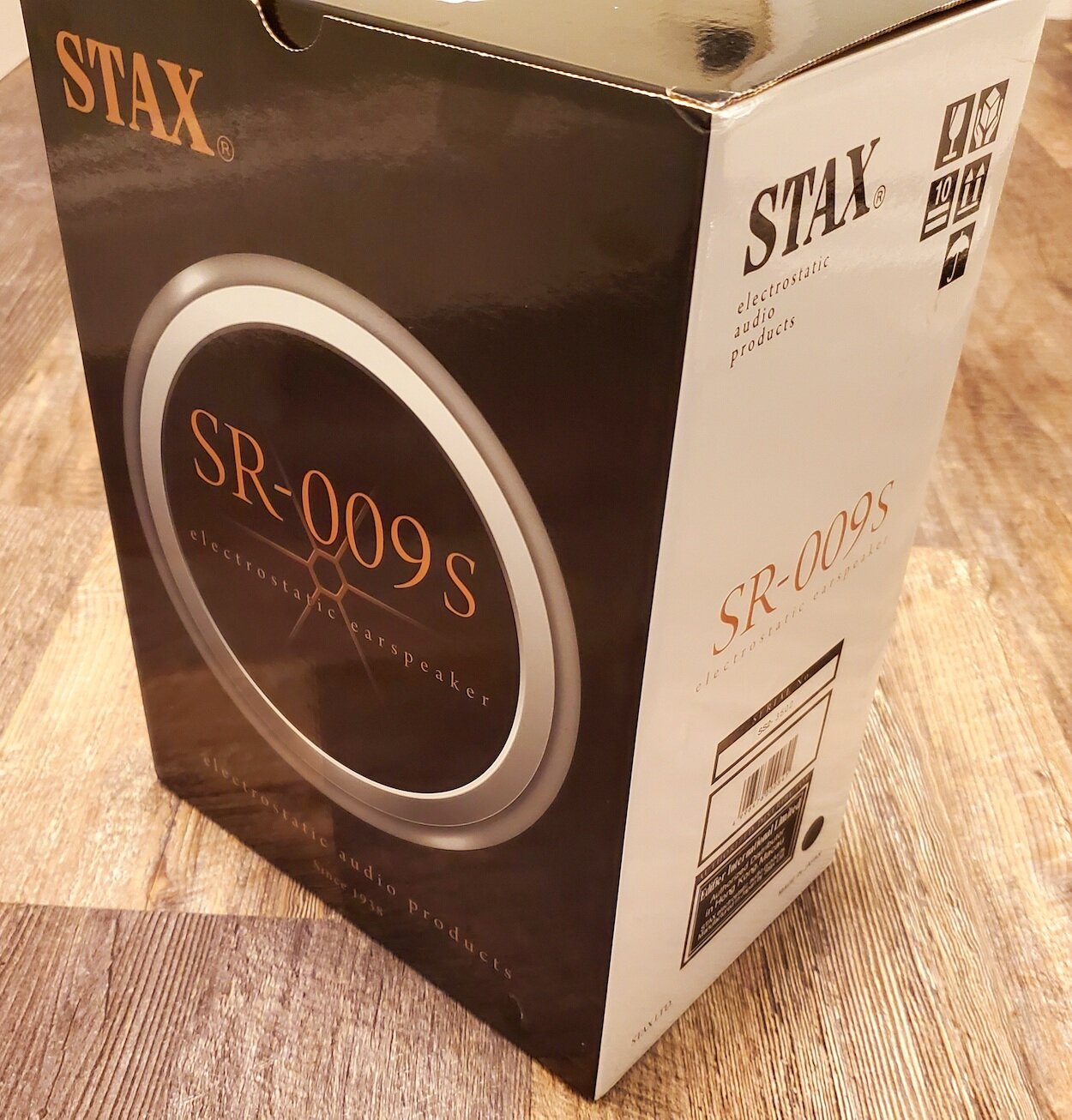THE PINNACLE OF HEADPHONE TECHNOLOGY AND OF TRANSPARENCY, COHERENCY, AND MUSICALITY!
The Blade Runner soundtrack (Blade Runner, East West) from the 1982 film plays as I begin the review of the STAX SR-009S earspeaker/headphone flagship. Fitting in how the Blade Runner soundtrack powerfully conjures the memory of a young man watching for the first time a movie, that would become a science fiction/film noir classic. And Rachel would be the name destined for one of my children. Alas, no children. Blade Runner remains, to this day one of the best science fiction movies ever produced (with voice over, of course). And now an earspeaker/headphone conjures a parallel experience and makes a similar impact.
Imagine for a moment, entering a world of music playback that meets the expectations the cynic in you did not believe possible. Imagine further, those expectations being surpassed by a component, an earspeaker/headphone that would serve as a time machine (Tardis) transporting you to performances—concert halls, jazz clubs, intimate venues, cafes, recording studios, etc.—across both time and space. Hyperbole? Blade Runner’s chief antagonist, Roy Batty (Rutger Hauer), a Nexus 6—artificial human—recites his own poignant elegy as he passes from the world at the end of a predetermined, four-year lifespan.
“I've seen things you people wouldn't believe. Attack ships on fire off the shoulder of Orion. I watched C-beams glitter in the dark near the Tannhäuser Gate. All those moments will be lost in time, like tears in rain. Time to die[1].”
And I’ve heard things in musical setups that most people have never experienced, nor would they believe, though the opportunity remains for some to hear them. And, perhaps, some already have. No, not hyperbole, at all, but please read on.
The company, STAX LTD, began operations in 1938. Then its primary products were condenser microphones, tone arms, phono cartridges, and electrostatic tweeters for traditional loudspeakers.
In 1960 STAX sold its first electrostatic earspeaker (headphone)—the SR-1. That same year STAX also developed and produced its first energizers (amplifiers)—the SRA-4S and the SRA-6S—designed specifically to drive its earspeakers, as electrostatic earspeakers cannot be driven by traditional headphone or integrated amps.
Over the intervening years STAX would develop and produce a range of earspeakers, energizers, and full-range electrostatic loudspeakers as well. In time, the STAX name would become synonymous for electrostatic earspeakers/headphones worldwide.
(Images courtesy of SuperBest Audio friends and inexxon)
At the present, STAX produces several electrostatic earspeakers—the SR-L300 ($284-its in-ear-earspeaker ), SR-L300 ($455-its entry-level earspeaker), SR-L500MkII ($830), SR-L700MkII ($1649), SR-007Mk2 ($2205), SR-007A ($2205), and the SR-009S ($4545-its flagship earspeaker), which is currently under review.
In an earlier review of a product I wrote:
“We review products across a relatively narrow band, a niche, if you will. And our niche is dichotomous, generally, in that it supposes great transparency and superb musicality can coexist in the same piece of audio equipment—headgear.”
When I had written this it was more wish, more desire, than bold prediction. Yet, I had not taken my first listen to an electrostatic earspeaker/headphone. I was not then aware of just how much transparency, clarity, coherency, and how much natural musicality was possible in any given component. Suffice to say, that a new awareness has arisen which has in turn validated that premise and bold prediction. The STAX line of earspeakers /headphones and subsequently the STAX energizers (amplifiers) have made this quite clear. As STAX itself states:
“STAX chose the electrostatic technology for its ability to produce transparent sound, and low weight for comfort/ergonomics, both due to the driver design not employing fixed magnets and moving coils, as opposed to other common headphone driver designs. The minimal weight of the driver ensures a very quick response to the signal, creating a more faithful sound reproduction.”
It is a point that I can now attest to having had the pleasure of several electrostatic headphones—STAX SR-009S, STAX SR-007A, STAX SR-L700MkII, and the Dan Clark VOCE—in house, at the same time, to take my very first electrostatic listening journey. One electrostatic earspeaker would, no doubt, have given me a point of reference on a geographical map of electrostatic sound. The combination, however, has laid out a state of sound, replete with terrain, altitude, and numerous points of interest, all bound together with incredible natural musicality! It has been an astonishing experience/journey, at the very least.
REFRAIN: Unlike most reviews, this review will be non-sequential, as it will start with how the headphones actually sound and not the process of physically “undressing” them and/or laying out their various parts, specifications, etc. Think of this review then, as a non-linear movie— In the Shadow of the Moon, Kill Bill, Pulp Fiction, The Queen’s Gambit, etc—that, likewise, starts at the end and winds its way to the beginning.
THE SOUND
Is it possible that tremendous transparency, resolution, and clarity can arouse anticipation? Imagine for a moment watching as Emmanuelle Bertrand sets bow to cello strings and, momentarily, holds the bow in place. There is anticipation of the notes, the music to soon flow forth. In this selfsame way the STAX SR-009S, perhaps, via its transparency, resolution, clarity, its blazing transient speed arouses the same kind of anticipation.
If you have not heard an electrostatic earspeaker, of quality, before then you will be in for quite a surprise, says this several decades, two-channel, music lover/audiophile, conveyer-belt-audio-gear-exchanger extraordinaire. As I wrote in my first encounter with an electrostatic headphone—the SR-L700MkII:
“Sophie Hunger’s Headlights (Rules of Fire, Two Gentlemen) plays and I am fooled again, as I turn to see where a particular sound has come from. It’s on the track %$&*@! … And it [STAX SR-L700MkII] will absolutely shine on live recordings, open halls, cathedrals, choral, chamber, symphony arrangements (with caveat[2]), intimate cafes, even rock (given the proper supporting equipment).”
The SR-007A would surpass its SR-L700MkII sibling and bring the marriage of transparency and richness across the entire frequency spectrum, which would be the envy of earspeakers and headphones the world over, with one exception.
The STAX SR-009S, the exception, brings it all—light-speed transients, you-are-right-there transparency; whole-cloth, top-to-bottom coherency, and all-bases-covered frequency extension. Mustn’t forget the natural tone/timbre, the delicacy, finesse, and nuance, the air, and a way with live anything that may well bliss one out (or, at least, make one happy-cry). Each of the STAX earspeakers would, in succession, prove more capable and more adept at powering the Yellow-Chair-Tardis and me, across time and space and venue.
It is said, and I paraphrase, that in the late 19th to early 20th century a patent office employee (or commissioner) advised that the patent office should close, as everything of importance had, in fact, already been invented. The historical accuracy of this phrase I cannot vouch for, but the sentiment, I can understand completely. I do, however, believe that more and better is still to come, though we may have to wait a good while longer for the electrostatic earspeakers to be replaced on the throne, in my opinion.
The STAX SR-009S’s volumetric cube—its soundstage—makes the SR-L700MkII’s and the SR-007S seem small in comparison and that is saying something. In short, you will realize across your extensive collections of albums, CDs, downloads, streaming libraries, that you have been missing vast amounts of music and the attendant space and air and nuance as well as other information. I mentioned in the review of the LTA Z10e, “the STAX SR-009S will be merciless in lining up sublime revelation after sublime revelation. Yeah, there’s that Star Trek holodeck, three-dimensionality, you-are-there thing going on, which just might freak some folks out.”
The STAX SR-009S was paired with the STAX SRM-700T headphone amplifier and LTA Z10e integrated/headphone amplifier, the Mola Mola Tambaqui and the Border Patrol SE-i DACs. The Roon Nucleus+ and a dedicated MacBook Air served as sources/streamers, and ANTICABLE and CARDAS delivered on the wire/cable tasks, while TORUS MAX provided the power.
BASS
When I reviewed the Border Patrol SE-i DAC, it was primarily with the STAX SR-009S. In this review, however, the Mola Mola Tambaqui has stepped in to take over from the award-winning Border Patrol SE-i DAC and to take things to another dimension. And it all starts with Marcus Miller’s Power (M2, Concord), which is propulsive, tight, fast, and as transparent as a summer’s day is long—unrivaled transparency. This is a trademark of electrostatic earspeakers, in general, and deservedly so, but it is more still with the STAX SR-009S. If it is one’s intent to dissect this piece by Marcus Miller, instead of enjoying it, then its dissection would be done and the various parts laid out across the stage, but musically so. It’s off now to the Minnesota Orchestra Hall (circa 1995-96) where Eiji Oue’s V. Infernal Dance of King Kashchey (Stravinsky, Reference Recording) powers in with the weight, dynamics, rising tension, and transient speed required for such a dramatic piece. The orchestra is rendered with such transparency and clarity that deep insight is offered into the soundstage and across its width, as every player, every instrument, every nuance is easily captured and heard. And after the furious crescendo of the Infernal Dance of King Kashchey, comes a quixotic tranquility, itself laid bare even in the sparsity of instrument and note. The power and the beauty of this movement rendered by the trio of STAX SR-009S, the Mola Mola Tambaqui, and the STAX SRM-700T is extraordinary! And this hearing like all others with this trio is without analog—peer. Christian McBride’s Fat Bach and Greens (Conversation with Christian, Mack Avenue Records) rolls in with its ruckus interplay of jazz and classical and the bass is potent, its transients ablaze, and its tonality and texture together channel a three-star, Michelin meal with dessert! In other words it is delicious and savory-sweet and beautifully laid out!
MIDRANGE
I listen now to Requiem, for orchestra, organ & chorus; for small ensemble, Op. 9 (three versions) (Duruflé, Signum Classics—Grammy Award Winner) air, space, nuance, crystalline clarity, and depth of stage are stunning. The 25 assembled voices of the Houston Chamber Choir is over the moon, laid bare, transcendent. Again I listen through the entire album, though I did not intend to. I follow with another exceptional choral album, Prayer for Peace - Sacred Choral Music In The Modern Age (Australian Broadcasting Company). Agnus Dei, Op. 11, as performed by the Cantillation, is profound, poignant, incredibly emotional, angelic. The entire album finds its way through me, with few notes taken, a blissful smile, and glorious contentment. Is choral music otherworldly with the STAX-009S? Yes, and in a way that puts me at a loss for words, or, perhaps, for the right words to describe what I’m hearing, feeling, experiencing. And it’s also making the review process very difficult. From choral to Sophie Hunger’s Walzer für niemand (Rules of Fire, Two Gentlemen), a live performance, now plays. I played Walzer für niemand in the review of the STAX SR-L700MkII’s. However, my Yellow-Chair-Tardis via the SR-009S brings me to the performance venue and places me between Sophie and violinist and in front of the piano. I am close enough to hear Sophie breathe, to hear the formation of word and phrase as they cross over lips into air and space and time. Brilliant! And then we’re off, via Yellow-Chair-Tardis, to Columbia's 30th street studio. Miles Davis’s So What (Kind of Blue, Blue Note) plays and it is up close and personal. There is greater transparency and three-dimensionality, nuance, and tonal truth coming from this album than I have ever experienced! I began listening to Kind of Blue at the age of five, nestled close to my mother, a huge jazz fan, while my feet dangled and air danced high above the floor. I would listen to my mother’s every word and I would know who was playing and their instrument of choice. Then we’d listen for hours. This hearing, however, is altogether new, as two-dimensional becomes three-dimensional and profoundly so, across the entirely of the Kind of Blue album. There is no better way to say this or to describe it. To believe that you know something and then to clearly understand that you do not know that something, nor have you ever really heard it, can either be disconcerting or wondrous. It was the latter for me, as it conjured beautiful memories.
TREBLE+
Treble extension? Get outta here! It’s incredible! Or as Buck Lightyear would say, “To infinity and beyond [3].” And he’d be almost right. Again, synergy is, truly, everything and its companions—the Mola Mola Tambaqui and the STAX SRM-700T (at present)—are themselves otherworldly and, certainly, do not hold the STAX SR-009S back. Put simply, there is no analog, no peer, no match for the pristine, treble extension, the sweet clarity, or the air that the STAX SR-009S offers its listeners. This becomes plainly obvious as soon as one listens to a treble-endowed recording, any treble-endowed recording. Should, however, there be flaws in that treble-endowed recording, then you will hear them, absolutely. Vilde Frang’s flawless performance (and recording) of Allegro Molto (Veress: String Trio - Bartók: Piano Quintet, Alpha) features violin plucks across the track that are corporeal, transient quick, and suffused with air. And as the treble reaches skyward and on to Alpha Centauri, completely undiminished (figuratively speaking), there is never stridency, nor harshness, nor grain. It is a preternaturally engaging journey—smooth, transparent, detailed, transient-quick, and rich—with the STAX SR-009S. And veils? I mentioned the falling away of veils in the STAX SR-L700MkII review and fall away they did, leaving a clearer picture of the music than any prior headphone had delivered. The STAX flagship—the SR-009S—pulls away veil after veil beyond its sibling’s every ability, until there is a sun-drenched, natural and organic clarity that no other earspeaker or headphone can touch, has touched! With this clarity comes tone and tonal shadings and texture so real, as to give naked truth to instruments and their voices and reveal them for what they are—flute, piccolo, English horn, viola, violin, cello, etc. And mustn’t forget the ambience, the nuance, and delicacy as rendered by the STAX SR-009S. Breathtaking!
THE WRAPPINGS AND ACCESSORIES



The STAX SR-900S comes in a medium-large, glossily printed, white box, that is minimalist, clean, with a photo of one of the SR-900S’s earspeakers on its front and back panels. Its sides and top/bottom are white and black respectively.
The inside container is a beautifully stained, wooden box. The top lifted, one finds the STAX SR-009S, held between two, thick, protective, identical foam inserts. The wooden box is not, however, a travel case. It is instead a show case made from a wood that is said to have a long history in Japan, for storing one’s valuables, and for defeating humidity.
The overall design is clean, the inner wooden box is a nice touch, though I long for the hardened, plastic-aluminum, travel case of the SR-007A, its less than half-priced sibling.
DESIGN—LOOK, FEEL, AND TECHNOLOGY

Round. Aluminum. Leather. Plastic. The sum of which come together in a rather elegant and sophisticated design. The STAX logo serves as a gold accent above each earspeaker and the silver-coated aluminum ear cups and the large gold-plated electrodes/stators within are quite beautiful.
The STAX SR-009S is an open back electrostatic earspeaker that like each of its siblings loses the magnets associated with planar magnetic headphones and dynamic driver headphones (and loses the coils of dynamic drivers as well). Electricity is delivered across the entirety of the electrodes/stators—thin, mylar, film diaphragm, sandwiched between two, conductive, metal plates—and is available on demand. The loss of the magnets also results in a reduction of overall mass. This would explain the speed, transparency, and the immediacy of the SR-009S’s transient response. And the SR-009S, with its incredibly soft ear pads, is very comfortable and may be worn for many hours without affect or ‘headphone head.’
The STAX SR-900S’s cable is composed of a six-strand, six-nines-copper (6NCu), low capacitance cable for the core wires and the six, silver-plated, copper wires that make up the perimeter, exactly like the SR-L700MkII. As STAX states, “The whole cable uses the conventional wide format parallel structure to lower the capacitance between each wires and finished with the most suitable structure to drive the earspeaker.” The various wires are housed within a plastic (rubber?) sheath. The cable is terminated in a five-prong assembly that allows connection to only electrostatic “energizers” or amplifiers, as electrostatic earspeakers cannot be driven by traditional amplification.
In sum, the STAX SR-009S is quite the looker, incredibly light, exceptionally comfortable, and can be worn for hours and hours on end without ill effects.
THE SPECIFICATIONS
STAX SR-009S
-
Type: push-pull electrostatic, oval sound element, rear open-air type enclosure
-
Frequency response: 7 – 41,000Hz
-
Electrostatic capacitance: 110pF (including attached cable)
-
Impedance: 145kΩ (including attached cable, at 10kHz)
-
Sound pressure sensitivity: 101dB / input 100Vr.m.s. / 1kHz
-
Maximum sound pressure level: 118dB / 400Hz
-
Bias voltage: 580V DC
-
Ear pad: real sheep’s leather (skin-touching portion), high-class artificial leather (surrounding portion)
-
Cable: parallel 6-strand, 2.5m full length, low-capacity special wide cable
-
Cable conductor:6N (99.9999%) annealed OFC with silver coating
-
Weight: 508g (1.1-lbs—including attached cable), 371g (0.8-lbs—without cable)
DRIVABILITY
The STAX SR-009S is much easier to drive than the SR-007A. Given their comparative specifications, the SR-009S’s impedance is 25kΩ less than its sibling and one 1db more sensitive, which translated into 10 to 15 steps of reduction in volume, depending on the Headphone amplifier. Interestingly, the SR-L700MkII and the SR-009S have the same specification in terms of overall sensitivity and, in this respect, both are easier to drive. The Dan Clark VOCE, on the other hand, is quite a bit more difficult to drive, than any of the STAX earspeakers and its specification, in terms of sensitivity remains a well guarded secret. Though I’d wager a guess it’s in the mid to low 90s, if not lower.
CONCLUSION
I like many others rode the audiophile conveyor belt of this component, then that, this speaker, then that, for decades. All to bring forth an experience, that I could not fathom, nor bring into being, nor ever truly describe. The why of it is now crystal clear. I was searching across the wrong world, so to speak, and using the wrong language, as it did not include electrostatic earspeaker and electrostatic energizer (amplifier).
The STAX SR-009S has remedied that and made listening to music these past months, an extraordinary gift for which I am very grateful. I have not had to lift, position, reposition, change out, or toe-in floor-standing speakers. I have not had to ‘treat’ or ‘analyze’ a room for anomalies that would affect the music in its journey to my ears. I’ve not had to negotiate with a significant other as to how far the speakers would be allowed into the living space or how large they could be. Nor have I had to sit at an optimal distance away from and between loudspeakers and by increments adjust my chair or head for a simulacrum of musical perfection. No, I just place the STAX SR-009S earspeakers over my ears, press the play icon on my iPad, and travel away, via Yellow-Chair-Tardis, to this venue and that, across time and space. My only luggage—a smile, a blissful disposition, an aperitif (occasionally and when not reviewing!), and consummate gratitude.
In truth, the STAX experience has transformed me into a dedicated headphone listener, as several decades of two-channel listening with systems into the low six figures, have never made this kind of a mark on me or revealed the music and its inner workings or summoned the magic to this degree. Never.
The STAX SR-009S may represent, for many, a transcendent listening experience. It may move you beyond expectation to that which you never imagined possible in a earspeaker or headphone. And should its stable of playmates be able—of good musical repute and like ability and up to task—then you will find yourself in another world of music, altogether and, like me, traveling across time and space, from venue to venue, experiencing sublime enjoyment. This is the magic of the STAX SR-009S and had I not experienced it, I would never have imagined it possible. Flagship? Yes, the STAX SR-009S is a true flagship earspeaker/headphone in every sense, with no rival, no peer, no successor to the throne, currently, and for the foreseeable future.
You will need an energizer to power the SR-009S. You’d probably want to start with, at least, the STAX SRM-005T ($1320), There is also the STAX SRM-007 TII ($1820), SRM-700T ($3400), or SRM-700S ($3400). And there is the STAX energizer flagship—the STAX SRM-T8000 ($6090, review coming soon)—or the LTA Z10e ($6950), which produced synergistic excellence with every STAX earspeaker as well as the Dan Clark VOCE (review coming soon).




